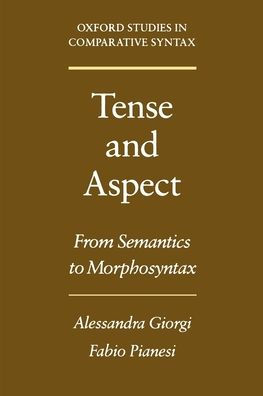| Symbols | xi |
| Introduction | xiii |
| 1. | The Syntactic and Semantic Background | 3 |
| 1.1. | The syntactic framework | 3 |
| 1.1.1. | The Split-Infl hypothesis | 3 |
| 1.1.2. | Chomsky's minimalist approach | 6 |
| 1.1.3. | A few words on phrase structure | 12 |
| 1.1.4. | Syncretic categories and the Feature Scattering Principle | 13 |
| 1.2. | The semantic representation | 17 |
| 1.2.1. | Tenses as sentential operators | 17 |
| 1.2.2. | Temporal entities | 22 |
| 1.2.3. | Events | 25 |
| 2. | On the Italian, Latin, and Portuguese Temporal Systems | 37 |
| 2.1. | The temporal projection | 37 |
| 2.2. | The Italian system | 40 |
| 2.3. | The Latin system | 45 |
| 2.4. | The Portuguese system | 47 |
| 2.5. | On nominative case assignment | 52 |
| Appendix | On the etymology of the Latin pluperfect and future perfect | 56 |
| 3. | The Present Perfect in Germanic and Romance | 67 |
| 3.1. | The morphosyntactic properties of the Germanic verbal systems | 68 |
| 3.1.1. | The morphosyntax of the English verbal system | 68 |
| 3.1.2. | Other Germanic languages | 76 |
| 3.1.3. | The position of negation | 79 |
| 3.1.4. | English modals again | 83 |
| 3.1.5. | On the present perfect puzzle | 84 |
| 3.1.6. | The simple past and the present perfect in Italian | 87 |
| 3.2. | The semantics of the present perfect | 90 |
| 3.2.1. | On the notion of consequent state | 90 |
| 3.2.2. | Some tentative speculations on the semantics of the present perfect and the simple past | 93 |
| 3.2.3. | A revision of the notion of consequent state | 97 |
| 3.2.4. | A compositional semantics for synthetic and analytic perfects | 99 |
| 3.2.5. | On the argumental status of temporal adverbials | 101 |
| 3.2.6. | The present perfect in English and MSc and temporal localizations | 111 |
| 3.2.7. | Toward an account of the present perfect puzzle | 114 |
| 3.3 | More on the present perfect in Italian-like languages | 118 |
| 3.3.1. | A note on Icelandic | 119 |
| 3.3.2. | The interpretation of the present perfect in Spanish and Catalon | 122 |
| 3.3.3. | The analysis of the Portuguese periphrastic present perfect | 123 |
| 3.4. | Some observations on the temporal and aspectual properties of the Italian present perfect | 126 |
| Appendix | The present perfect in Catanese and Vicentino | 133 |
| 4. | The Present and Imperfect in Germanic and Romance | 151 |
| 4.1. | The present tense | 152 |
| 4.1.1. | Crosslinguistic evidence | 152 |
| 4.1.2. | The structure of events | 154 |
| 4.1.3. | Punctuality and the properties of the speech event | 157 |
| 4.1.4. | A revised notion of punctuality | 158 |
| 4.1.5. | The present tense and perfectivity | 160 |
| 4.2. | On the present-in-the-past interpretation of embedded events in Germanic and Romance | 173 |
| 4.2.1. | The Italian imperfect: a characterisation | 173 |
| 4.2.2. | Comparative evidence | 181 |
| 5. | On the Semantics and Morphosyntax of the Italian Subjective | 193 |
| 5.1. | Toward a semantics of the subjunctive | 193 |
| 5.1.1. | The data | 194 |
| 5.1.2. | Previous accounts | 201 |
| 5.1.3. | Mood and modality | 205 |
| 5.1.4. | Mood in subordinate clauses | 211 |
| 5.1.5. | Factive predicates | 218 |
| 5.1.6. | Dream and its companions | 220 |
| 5.1.7. | Intralinguistic variations in mood choice | 223 |
| 5.1.8. | Other factors affecting mood choice | 224 |
| 5.1.9. | Concluding remarks | 228 |
| 5.2. | The morphosyntax of the Italian subjunctive | 230 |
| 5.2.1. | Syncretic categories and the Feature Scattering Principle | 230 |
| 5.2.2. | Subject-Verb inversion phenomena in Italian | 232 |
| 5.2.3. | The V-to-C solution | 236 |
| 5.2.4. | The syncretic category solution | 239 |
| 5.2.5. | Extraction from subjunctive clauses | 247 |
| 5.2.6. | Conclusions | 256 |
| Appendix | Conditionals and counterfactuals | 256 |
| 6. | The Double Accessibility Reading in Italian and English | 280 |
| 6.1. | The Double Accessibility Reading | 280 |
| 6.2. | The Italian data | 282 |
| 6.3. | The English data | 285 |
| 6.4. | Conclusions | 289 |
| References | 293 |
| Author Index | 304 |
| Subject Index | 308 |



